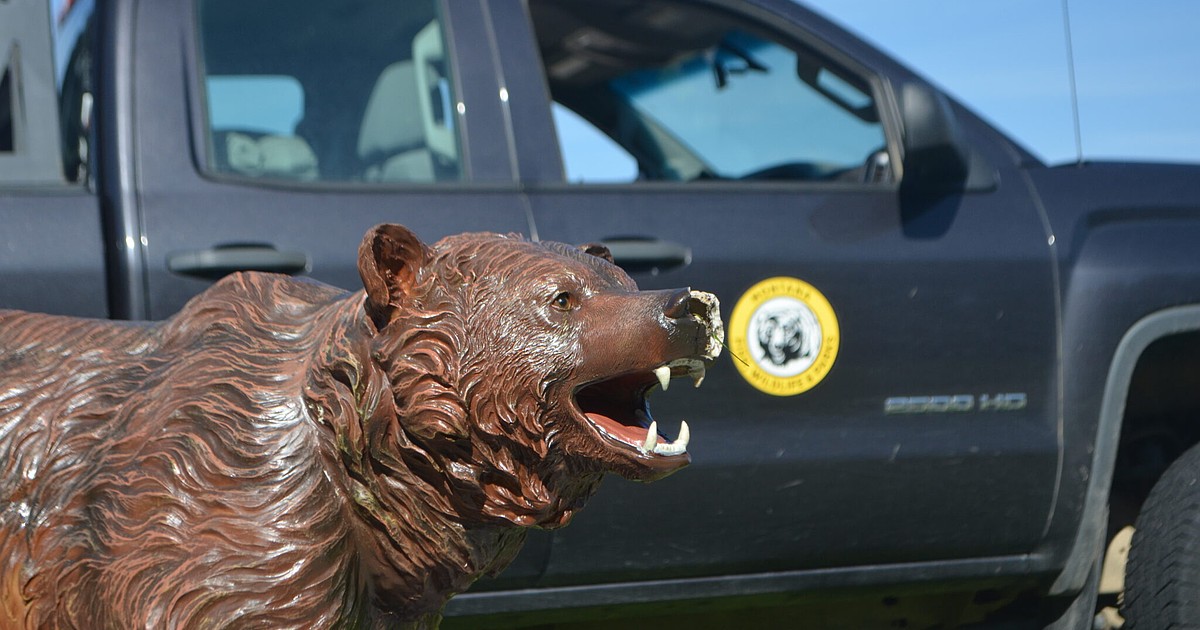
LOLO – Reaction time during a bear encounter is the focus of a new effort from Montana Fish, Wildlife and Parks to better educate the public about grizzlies and black bears.
And it involves a bear on wheels that can reach about the same top speed as a grizzly can — more than 30 mph. The bear is not life sized, but isn’t tiny and stands on what is essentially a four-wheeled souped-up radio controlled car.
The training trailer and its educational content come from a partnership between FWP, Montana’s Outdoor Legacy Foundation (MOLF), with support from Safari Club International (SCI) Foundation, the Western Montana Chapter of SCI, and the U.S. Fish & Wildlife Service.
The exercise involves inert bear spray, which a person can use when the bear is rushing at them. It’s an opportunity to find out how quickly you can get the spray up, get the safety off and squeeze the trigger.
Bear spray essentially acts as a barrier, and it’s important to discharge it correctly — forward and at a slightly downward angle, as a rushing bear’s nose and mouth will be low to the ground.
Getting these types of tips out and giving people the opportunity to see how they would react is important, FWP bear technician Brandon Davis said at an event at Travelers’ Rest State Park in Lolo this weekend.
“A lot of people don’t know there’s bears around, that there’s grizzlies, and so we’re just trying to get people involved,” Davis said. “And just give them that muscle memory so their first time pulling out a bear spray isn’t on the trail.”
Bears have personalities, unique characteristics, can be a multitude of different colors and need personal space, Davis said. They are complicated, nuanced creatures and the education and outreach is in part to help the public understand more about them.
“Some (bear encounters) are really quick, and there’s not much you can do,” Davis said. “But there are times when you can look at the behavior and read that animal.”
Surprising a bear can often evoke a quick response from the bear, and it’s important to hold your ground — timid bears will often not attack someone who holds their ground. Bears also have faux charges.
For example, a female bear with offspring will aggressively defend her cubs. Running away from a bear can actually trigger a chase response from the bear.
Grizzlies and black bears also don’t act the same — black bears seem to rely on bluffing as opposed to a mauling. A grizzly encounter can be deadly, and recognizing these signs and doing what you can to not surprise any bear is important.
Autumn means bears are trying to consume as many calories as possible in a very short time, though rarely do bears attack humans in the name of eating them specifically.
Fear is one of the biggest misconceptions when it comes to bears, he added.
“These are big animals. They have the potential to kill you. But they’re not out to hurt you,” Davis said. “I mean, there’s always an outlier, that’s a generalization, but I think most of the time they just want to get away.”
During hunting season, Davis said, hunters need to be careful about gut piles, especially this time of year. That’s one of the times people can accidentally bring bears into an area.
Davis said FWP recently set up a camera in an area near a hunter’s kill, and within 24 hours there were bears in the area. Hikers and backpackers should also be aware of carcasses on or near trails, which was the case in a bear encounter in Yellowstone National Park earlier this month.
In that case, a solo hiker surprised a bear near a carcass. The bear charged, the hiker discharged bear spray and suffered injuries that sent the man to the hospital, but were not life-threatening.
This year has, luckily, not seen many bad human-bear conflicts. Rebekah Ficek, an Americorps VISTA member with Travelers Rest Connection, is hoping the event helps keep it that way. She helped organize the event and used to do Americorps work with FWP. That’s where her interest in the creatures began, she said.
“I just really love working with bears, because I feel like they can be misunderstood,” Ficek said. “They’re just wildlife that can kind of get a bad rap sometimes.”
Ficek demonstrated proper usage of the bear spray and helped work with a number of people who cycled through the event. There was a steady flow of people throughout the day, which staff were happy about.
She was also happy to push back against one particular misconception.
“A lot of people think bear spray is actually bug spray,” Ficek said. “They try and spray it on themselves. We try so hard to reiterate, no, no, no, do not spray it on yourself. It is pepper spray, not bug spray. I’ve gotten that a lot.”
In addition to a variety of literature, the event also had taxidermy bears and lots of stories, along with plenty of stickers.
FWP staff also takes old and expired bear spray at any regional FWP office. A lot of bear spray also gets left at airports when tourists buy them and then can’t be taken back on a plane.
Throughout the month of September, which is Bear Aware month for the state, the agency is hosting more Bear Aware events across the state. A bear awareness event will be held at the Troy Apple Festival in downtown Troy on Sept. 26 from 2 p.m. to 6:30 p.m.



